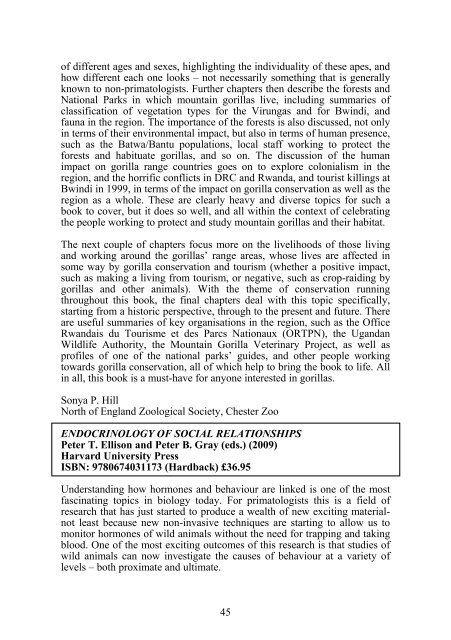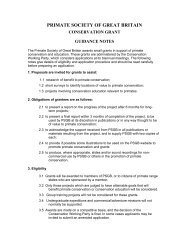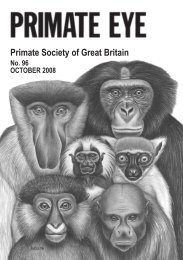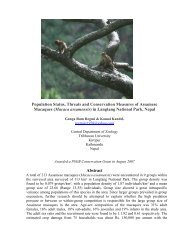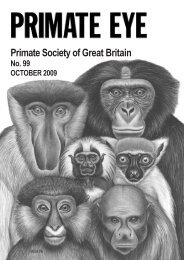2010 Vol 101.pdf (1.63mb) - Primate Society of Great Britain
2010 Vol 101.pdf (1.63mb) - Primate Society of Great Britain
2010 Vol 101.pdf (1.63mb) - Primate Society of Great Britain
Create successful ePaper yourself
Turn your PDF publications into a flip-book with our unique Google optimized e-Paper software.
<strong>of</strong> different ages and sexes, highlighting the individuality <strong>of</strong> these apes, and<br />
how different each one looks – not necessarily something that is generally<br />
known to non-primatologists. Further chapters then describe the forests and<br />
National Parks in which mountain gorillas live, including summaries <strong>of</strong><br />
classification <strong>of</strong> vegetation types for the Virungas and for Bwindi, and<br />
fauna in the region. The importance <strong>of</strong> the forests is also discussed, not only<br />
in terms <strong>of</strong> their environmental impact, but also in terms <strong>of</strong> human presence,<br />
such as the Batwa/Bantu populations, local staff working to protect the<br />
forests and habituate gorillas, and so on. The discussion <strong>of</strong> the human<br />
impact on gorilla range countries goes on to explore colonialism in the<br />
region, and the horrific conflicts in DRC and Rwanda, and tourist killings at<br />
Bwindi in 1999, in terms <strong>of</strong> the impact on gorilla conservation as well as the<br />
region as a whole. These are clearly heavy and diverse topics for such a<br />
book to cover, but it does so well, and all within the context <strong>of</strong> celebrating<br />
the people working to protect and study mountain gorillas and their habitat.<br />
The next couple <strong>of</strong> chapters focus more on the livelihoods <strong>of</strong> those living<br />
and working around the gorillas’ range areas, whose lives are affected in<br />
some way by gorilla conservation and tourism (whether a positive impact,<br />
such as making a living from tourism, or negative, such as crop-raiding by<br />
gorillas and other animals). With the theme <strong>of</strong> conservation running<br />
throughout this book, the final chapters deal with this topic specifically,<br />
starting from a historic perspective, through to the present and future. There<br />
are useful summaries <strong>of</strong> key organisations in the region, such as the Office<br />
Rwandais du Tourisme et des Parcs Nationaux (ORTPN), the Ugandan<br />
Wildlife Authority, the Mountain Gorilla Veterinary Project, as well as<br />
pr<strong>of</strong>iles <strong>of</strong> one <strong>of</strong> the national parks’ guides, and other people working<br />
towards gorilla conservation, all <strong>of</strong> which help to bring the book to life. All<br />
in all, this book is a must-have for anyone interested in gorillas.<br />
Sonya P. Hill<br />
North <strong>of</strong> England Zoological <strong>Society</strong>, Chester Zoo<br />
ENDOCRINOLOGY OF SOCIAL RELATIONSHIPS<br />
Peter T. Ellison and Peter B. Gray (eds.) (2009)<br />
Harvard University Press<br />
ISBN: 9780674031173 (Hardback) £36.95<br />
Understanding how hormones and behaviour are linked is one <strong>of</strong> the most<br />
fascinating topics in biology today. For primatologists this is a field <strong>of</strong><br />
research that has just started to produce a wealth <strong>of</strong> new exciting materialnot<br />
least because new non-invasive techniques are starting to allow us to<br />
monitor hormones <strong>of</strong> wild animals without the need for trapping and taking<br />
blood. One <strong>of</strong> the most exciting outcomes <strong>of</strong> this research is that studies <strong>of</strong><br />
wild animals can now investigate the causes <strong>of</strong> behaviour at a variety <strong>of</strong><br />
levels – both proximate and ultimate.<br />
45


